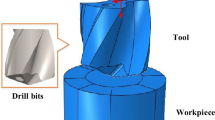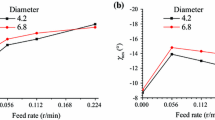Abstract
Drilling mechanics model has always been the key and difficult point in the research field of gun drilling. In this paper, through theoretical analysis and processing experiments, the gun drilling mechanics model of Ti6Al4V titanium alloy is studied. On the one hand, based on the Oxley cutting model and the Johnson-Cook flow stress model, this paper takes Ti6Al4V titanium alloy as the research object and use the “microelement” method to establish the mechanical model of gun drilling, which includes cutting parameters, tool geometric parameters and material mechanical properties. On the other hand, the drilling model considers the influence of process damping and verified by experiments. The results show the calculated value of the model is consistent with the experimental value and the error is within the acceptable range. The model provides a theoretical basis for the prediction of drilling force, tool analysis and straightness error analysis.















Similar content being viewed by others
References
Biermann D, Bleicher F, Heisel U et al (2018) Deep hole drilling [J]. CIRP Ann-Manuf Techn (67):673–694
Armarego EJA, Cheng CY (1972) Drilling with flat rake face and conventional twist drills—I. Theoretical investigation [J]. Int J Mach Tools Manuf (12):17–35
Griffiths BJ (1993) Modelling complex force systems, Part 1: the cutting and pad forces in deep drilling [J]. Part 1: The cutting and pad forces in deep drilling. Journal of Engineering for Industry, 115(115):169–176
Jung J, Feng K (2007) A gun drilling force system [J]. Int J Mach Tool Manu 47:1276–1284
Wang Y, Wang Y, Wang Y (2014) The force system and performance of the welding carbide gun drill to cut AISI 1045 steel [J]. Int J Adv Manuf Technol 74:1431–1443
Liang Li, Ning He, Peng Wu, et al. A gun drill mechanics model analysis based on 15-5PH solid solution stainless steel [J]. Mach Sci Technol, 2019, 23(2):218-231.
Astakhov VP, Osman MOM (1996) An analytical evaluation of the cutting forces in self-piloting drilling using the model of shear zone with parallel boundaries. Part1: Theory [J]. Int J Mach Tools Manuf 36:1187–1200
Astakhov VP, Osman MOM (1996) An analytical evaluation of the cutting forces in self-piloting drilling using the model of shear zone with parallel boundaries.Part2: Application [J]. Int J Mach Tools Manuf 36:1335–1345
Oxley PLB, HT YT (1990) mechanics of machining: an analytical approach to assessing machinability [M]. J Appl Mech 57:253–260
Wang ZG, Rahman M, Wong YS, Li XP (2005) A Hybrid Cutting Force Model for High-Speed Milling of Titanium Alloys [J]. CIRP Annals, 54(1):71–74
Johnson GR, Cook WH (1985) Fracture characteristics of three metals subjected to various strains, strain rates, temperatures and pressures [J]. Eng Fract Mech 21(1):31–48
Umbrello D (2008) Finite element simulation of conventional and high speed machining of Ti6Al4V alloy [J]. J Mater Process Technol 196(1):79–87
Shivpuri R, Hua J, Mittal P (2001) Microstructure-mechanics interactions in modeling chip segmentation during titanium machining [J]. CIRP Ann 51(1):71–74
Lee WS, Lin CF (1998) Plastic deformation and fracture behavior of Ti6Al4V alloy [J]. Mater Sci Eng A 241:48–59
Li L, He N (2006) A FEA study on mechanisms of saw-tooth chip deformation in high speed cutting of Ti-6-Al-4 V alloy. In: Fifth International Conference on High Speed Machining (HSM), pp 759–767
Özel T, Zeren E (2004) Determination of work material flow stress and friction for FEA of machining using orthogonal cutting tests [J]. J Mater Process Technol 153-154):1019–1025
Meyer HW, Kleponis DS (2001) Modeling the high strain rate behavior of titanium undergoing ballistic impact and penetration [J]. Int J Impact Eng 26:509–521
Calamaz M, Coupard D, Girot F (2008) A new material model for 2D numerical simulation of serrated chip formation when machining titanium alloy Ti-6Al-4V [J]. Int J Mach Tool Manu 48:275–288
Lalwani DI, Mehta NK, Jain PK (2009) Extension of Oxley’s predictive machining theory for Johnson and Cook flow stress model [J]. J Mater Process Technol 209(12-13):5305–5312
Boothroyd G, Knight WA (1988) Fundamentals of metal machining and machine tool [J]. Fire Saf J 25(2):171–173
Ahmadi K, Ismail F (2012) Stability lobes in milling including process damping and utilizing multi-frequency and semi-discretization methods [J]. Int J Mach Tools Manuf 54-55(54):46–54
Altintas, Yusuf. (2000). Manufacturing automation: metal cutting mechanics, machine tool vibrations, and CNC design, First Edition, Cambridge University Press, March 2000. ISBN 0-521-65973-6.
Waldorf DJ (2006) Simplified model for ploughing forces in turning [J]. J Manuf Process 8(2):76–82
Bissacco G, Hansen HN, Slunsky J (2008) Modelling the cutting edge radius effect for force prediction in micro milling [C]. Annals of the CIRP 57(1):113–116
Sandvik AB (2018) Sandviken, Sweden. www.coromant.sandvik.com/cn
Acknowledgments
Part of this work was supported by the National Natural Science Foundation of China (No. 51505409).
Author information
Authors and Affiliations
Corresponding author
Additional information
Publisher’s note
Springer Nature remains neutral with regard to jurisdictional claims in published maps and institutional affiliations.
Rights and permissions
About this article
Cite this article
Li, L., He, N., Hao, X. et al. Deep-hole gun drilling mechanics model of Ti6Al4V alloy based on Johnson and Cook flow stress model. Int J Adv Manuf Technol 104, 4497–4508 (2019). https://doi.org/10.1007/s00170-019-04244-6
Received:
Accepted:
Published:
Issue Date:
DOI: https://doi.org/10.1007/s00170-019-04244-6




